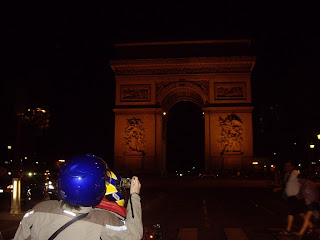"Avoid the coast!", He warned. "The winds are strong and gusty."
The weather report confirmed his advice, further adding that a coming storm will drench the whole region. If we were to work our way a little further south we will likely run into seasonal high winds near the Mediterranean Sea which the French call "le Mistral". The Mistral winds can average speeds of about 50 kilometers an hour during the day, which is not a lot of fun on a motorcycle.
Taking a look at our options, we decided to head to Spain for a few days.
Zaragoza is within a day's ride and it's an interesting place to hang out for a few days. We will ride over the Pyrenees into Spain until we get to Lerida (Lleida) then north to Zaragoza on the longest, straightest, boringest stretch of road we have been on so far this trip.
It's a plan.
The day is fair and sunny as we leave Toulouse, heading west on the highway through flat corn-field farmland; to our left we can see the silhouettes of the mountains like layered gray torn-paper silhouettes against the sky. Within an hour we are heading south, towards the border between France and Spain and into the mountains.
The pass is not particularly high, but beautiful. The Pyrenees are mostly composed of masses of hard gray granite rock, which is fairly resistant to erosion, wild and sparsely populated. While there is not much in the way of snow cap, we pass by many small streams and mountain torrents and through dramatic narrow rocky gorges.
Descending into the Spanish side of the mountains, we find ourselves often stuck behind large trucks who have chosen to avoid the toll roads and take the small mountain roads instead. As we descend we pass through villages, through acres of fruit orchards ripe with apples, peaches, cherries, oranges, we also experience the stomach-turning smell of pig farms and occasional trucks laden with pigs, their pink snouts and butts pressed up against the mesh sides of their enclosure on the truck. Spain has some of the best pork in the world; the smell is the downside. We try to hold our breath as long as possible as we pass the trucks and leave them as far behind us as we can.
Once out of Lerida, we hit the highway. The land has almost completely flattened out and is brown and dry and dusty; the road stretches out in front of us, straight as far as the eye can see. Within a few hours we are in Zaragoza.
Zaragoza is not on the international tourist trail, though it has many things worth seeing. The main draw for visitors is probably the beautiful Basilica del Pilar, set on the banks of the river Ebro. There are also many remains from the Romans (who gave the town its name) which one can visit; Forum, baths, ampitheatre, port, city walls. There are also many buildings that show the mark of the Moorish occupation; such as churches with beautiful Islamic style designs on the outside and bell towers that resemble the square minarets of the Moors.
 |
| Moorish decoration on the side of a church |
 I have talked often about the pilgrimages in Europe, notably the trail to Santiago de Compostela; the basilica here is an important stop. If you know the story of Saint James, you probably already know that he had a vision that the virgin Mary appeared to him on a pillar of flame; the pillar purportedly appearing here in Zaragoza in the spot where the basilica is now.
I have talked often about the pilgrimages in Europe, notably the trail to Santiago de Compostela; the basilica here is an important stop. If you know the story of Saint James, you probably already know that he had a vision that the virgin Mary appeared to him on a pillar of flame; the pillar purportedly appearing here in Zaragoza in the spot where the basilica is now.By the way, in case you were wondering about the title of the post, Thara-Gotha is an approximation of how the Spanish pronounce Zaragoza...









































